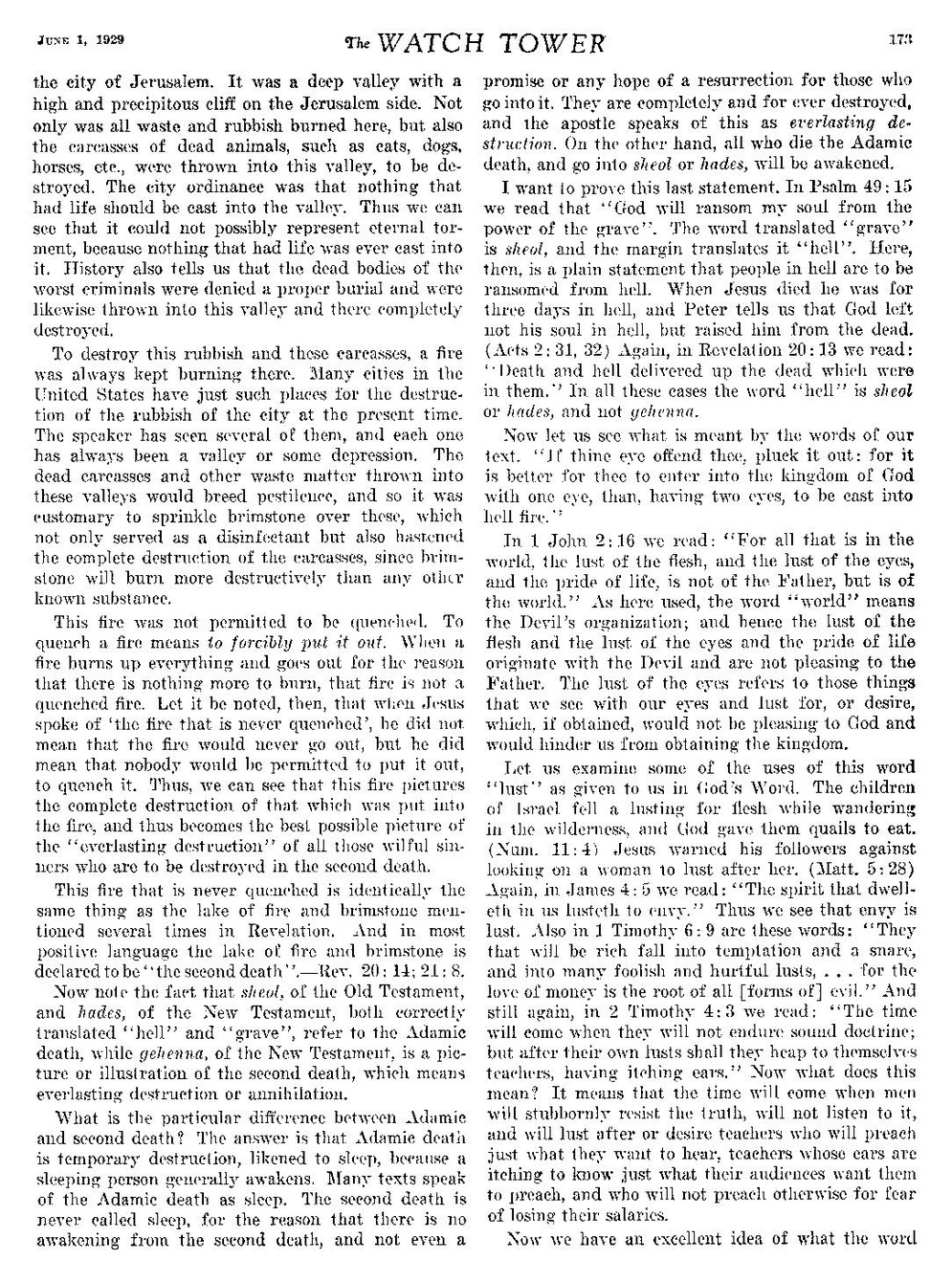To destroy this rubbish and these carcasses, a fire was always kept burning there. Many cities in the United States have just such places for the destruction of the rubbish of the city at the present time. The speaker has seen several of them, and each one has always been a valley or some depression. The dead carcasses and other waste matter thrown into these valleys would breed pestilence, and so it was customary to sprinkle brimstone over these, which not only served as a disinfectant but also hastened the complete destruction of the carcasses, since brimstone will burn more destructively than any other known substance. This fire was not permitted to be quenched. To quench a fire means to forcibly put it out. When a fire burns up everything and goes out for the reason that there is nothing more to burn, that fire is not a quenched fire. Let it be noted, then, that when Jesus spoke of 'the fire that is never quenched', he did not mean that the fire would never go out, but he did mean that nobody would be permitted to put it out, to quench it. Thus, we can see that this fire pictures the complete destruction of that which was put into the fire, and thus becomes the best possible picture of the "everlasting destruction" of all those wilful sinners who are to be destroyed in the second death. This fire that is never quenched is identically the same thing as the lake of fire and brimstone mentioned several times in Revelation. And in most positive language the lake of fire and brimstone is declared to be "the second death". - Rev. 20:14; 21:8. Now note the fact that sheol, of the Old Testament, and hades, of the New Testament, both correctly translated "hell" and "grave", refer to the Adamic death, while gehenna, of the New Testament, is a picture or illustration of the second death, which means everlasting destruction or annihilation. What is the particular difference between Adamic and second death? The answer is that Adamic death is temporary destruction, likened to sleep, because a sleeping person generally awakens. Many texts speak of the Adamic death as sleep. The seeond death is never called sleep, for the reason that there is no awakening from the second death, and not even a
promise or any hope of a resurrection for those who go into it. They are completely and for ever destroyed, and the apostle speaks of this as everlasting destruction. On the other hand, all who die the Adamic death, and go into sheol or hades, will be awakened. I want to prove this last statement. In Psalm 49:15 we read that "God will ransom my soul from the power of the grave". The word translated "grave" is sheol, and the margin translates it "hell". Here, then, is a plain statement that people in hell are to be ransomed from hell. When Jesus died he was for three days in hell, and Peter tells us that God left not his soul in hell, but raised him from the dead. (Acts 2:31,32) Again, in Revelation 20:13 we read: "Death and hell delivered up the dead which were in them." In all these cases the word "hell" is sheol or hades, and not gehenna. Now let us see what is meant by the words of our text. "If thine eye offend thee, pluck it out: for it is better for thee to enter into the kingdom of God with one eye, than, having two eyes, to be cast into hell fire." In 1 John 2:16 we read: "For all that is in the world, the lust of the flesh, and the lust of the eyes, and the pride of life, is not of the Father, but is of the world." As here used, the word "world" means the Devil's organization; and hence the lust of the flesh and the lust of the eyes and the pride of life originate with the Devil and are not pleasing to the Father. The lust of the eyes refers to those things that we see with our eyes and lust for, or desire, which, if obtained, would not be pleasing to God and would hinder us from obtaining the kingdom. Let us examine some of the uses of this word "lust" as given to us in God's Word. The children of Israel fell a lusting for flesh while wandering in the wilderness, and God gave them quails to eat. (Num. 11:4) Jesus warned his followers against looking on a woman to lust after her. (Matt. 5:28) Again, in James 4:5 we read: "The spirit that dwelleth in us lusteth to envy." Thus we see that envy is lust. Also in 1 Timothy 6:9 are these words: "They that will be rich fall into temptation and a snare, and into many foolish and hurtful lusts, ... for the love of money is the root of all [forms of] evil." And still again, in 2 Timothy 4:3 we read: "The time will come when they will not endure sound doctrine; but after their own lusts shall they heap to themselves teachers, having itching cars." Now what does this mean? It means that the time will come when men will stubbornly resist the truth, will not listen to it, and will lust after or desire teachers who will preach just what they want to hear, teachers whose ears are itching to know just what their audiences want them to preach, and who will not preach otherwise for fear of losing their salaries.
Now we have an excellent idea of what the word